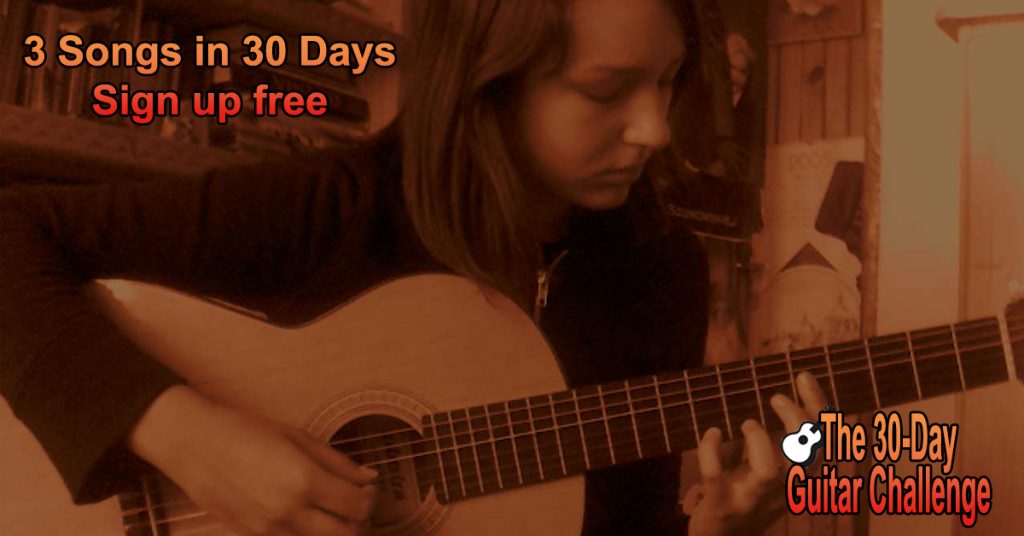In your last lesson, “How To Read Guitar Notes For Beginners“, we talked about the different parts of the staff and how the pitch notations are used.
One definition of music is that it’s sounds laid out over time. We’ve talked about the sound part. Next we’ll get into time. In this article we’ll talk about rhythm. There are two parts to every note: what note to play (pitch) and how long to play it for (rhythm).
We’ll start with the five basic kinds of rhythm notes.
A whole note is four beats. That simply you means you play the note and hold it while you count to four. A half note is two beats. You’re still going to count to four, but you’ll play each note for just two beats. That means you’ll strike the note on beats 1 and 3. A quarter note is one beat, so you’ll play the note on every beat, 1, 2, 3, and 4. Learn to tap your foot on each number.
An eighth note gets half of a beat. Now you may be wondering, what the heck is half a beat? Think of it this way… If you tap your foot in a steady tempo there is an amount of time in between the beats of your foot. That time can be divided into smaller increments.
|———————–|———————–|
Beat 1 Half Beat Beat 2
When your foot comes down we call that the downbeat. When your foot comes up, we call that the upbeat.
Here’s a measure of eighth notes we can count.
You can see that we count 1 & 2 & 3 & 4 & – Your foot goes down on the numbers and up on the “and”. That gives us two eighth notes per beat.
Our last example above is a sixteenth note, which gets a quarter of a beat. Again, we’re just dividing the beat into smaller increments. We’ll have four sixteenth notes in a beat and they’re counted: 1-e-&-a, 2-e-&-a, etc.
Another aspect of rhythm that you’ll often see is a tie. A tie looks like a curved line connecting two notes.
When two notes are tied together, you only pick the first one and just let it ring through the second one. In the example above you would play on the “&” of beat 2 and let it ring through beat 3 without picking it again. Later in the measure you’ll pick the “&” of beat 4 and let it ring through the following whole note without picking again.
Once you start to get the hang of these basic rhythm notes, you’ll also run across notes with a little dot next to them. A dot adds half as much value to the note:
Dotted Whole Note = 6 beats (4 +2) – Like a whole note tied to a half note.
Dotted Half Note = 3 beats (2 +1) – Like a half note tied to a quarter note.
Dotted Quarter Note = 1 1/2 beats (1 +1/2) – Like a quarter note tied to an eighth note.
Dotted Eighth Note = 3/4 beat (1/2+1/4) – Like an eighth note tied to a sixteenth note.
Action Step: Find a piece of music that doesn’t look too wacko rhythmically. Take a small portion of the piece. No more than four measures. Try clapping the rhythm. Do that until your comfortable with it. Then grab your guitar, pick out just one note, and play the whole rhythm on that one note. Once you’ve got that section, start on a new one.
Side Note:
If you don’t own a metronome yet, I highly suggest getting one. In these early stages you can’t trust your foot to keep a steady tempo because we’re still developing all that stuff. A metronome will help you develop a rock steady tempo. And in my opinion, having a good sense of tempo and great rhythm is more important than getting the notes exactly right. Even an inexperienced listener can catch a rhythm or tempo mistake, but most don’t hear small pitch mistakes.
If you have a smartphone, there are free metronome apps available. Or if you prefer the real thing, I can suggest the Qwik Time QT-3 Quartz Metronome (an inexpensive choice at $14.95) or a Matrix MR-800 Quartz Metronome
(a bit more money, but the click is way less annoying – $39.99)
If you have any questions on how to read rhythm notes or problems with the ideas in this article, please leave a comment below and I’ll answer it asap.
Check this out to learn my best guitar fretboard reading tricks.
Get my guide to the “12 Parts of Playing Guitar You Need To Know” plus “The Perfect Practice Session” by sending out a quick tweet with the Tweet2Download button below.
12GuitarThingsPerfectPrac ..





When you state, “above you would play on the “&” of beat 2 and let it ring through beat 3 without picking it again” does that mean you play 2, &, but you dont play 3?
Yep, that’s absolutely correct Guillermo. Thanks for clarifying.
I really wanna learn guitar and become world s best guitarist ..but the problem is ain’t got money..so can u help me plz..
Fortunately you don’t need money. You need a guitar, hands, and time. Keep playing and always set goals that are slightly out of reach.